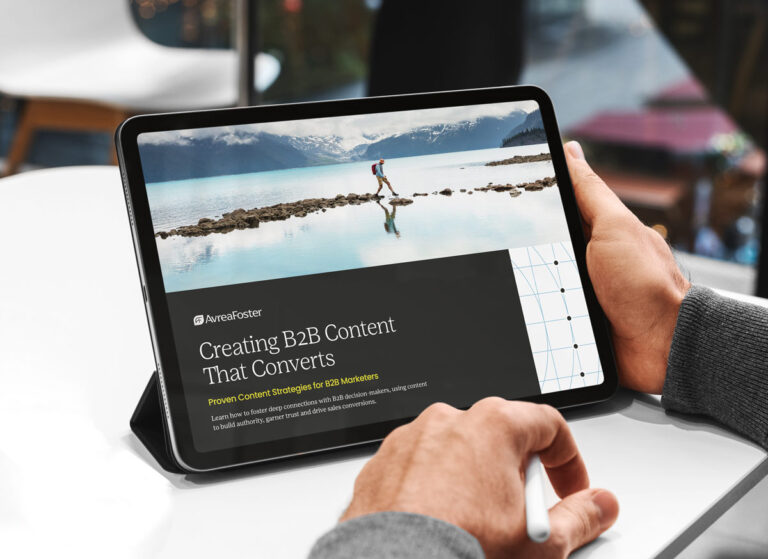This era of digital marketing is dominated by reporting dashboards and the mountain of metrics they provide. On one hand, it has never been easier to gain complete visibility into every aspect of B2B marketing performance. On the other hand, though, it can be quite difficult to decipher the difference between the data that’s truly meaningful and the data that is more ancillary.
Here, we’ll discuss that challenge in detail and provide B2B marketers with our perspective on which metrics are most critical — presented in the context of their funnel stages.
The B2B Reporting Data Challenge
According to Salesforce, marketers use an average of 18 data sources for reporting. With all of that input, it’s vitally important that B2B digital marketers are able to explain the why behind the numbers — the fact-based story that puts insights in context and brings opportunities for improvement to light.
This is especially true when marketing metrics need to be evaluated by stakeholders who are less than digital marketing-savvy. The result of this deluge of data can be confusion or, worse, complete disengagement.
The nickname for when these data points are used to paint a picture of false-positive outcomes is vanity metrics. The fact is, you’re not always going to achieve perfect or even good metrics over some reporting periods. So it’s critical that you have information at the ready that explains why performance was poor so you can strategize how to pivot and improve.
Another facet of the challenge of prioritizing B2B marketing metrics is understanding what different stakeholder groups care about. The C-suite may have different priorities than the sales team, which has different priorities than the marketing team. In the B2B world, these teams often are siloed and burdened with long sales cycles — further muddying the waters.
Our Approach: B2B Marketing Metrics by Funnel Stage
There are numerous ways to segment data, but separating metrics by funnel stage is our recommendation when taking all stakeholders into account. Funnel-stage segmentation is a great way to touch on key marketing-related KPIs and align them from the beginning of the buyer’s journey to its conclusion.
To be clear, this list of marketing metrics separated by funnel stage does not include the more granular data points you’d consider on a channel-by-channel basis, and that is intentional. For the purpose of broad application, we’re striving for a metric set that provides comprehensive coverage and avoids metrics that are highly dependent on a unique campaign strategy, specific sales cycle or particular channel.
Again, across all of these metrics, consider the totals as well as source-by-source and campaign-level data.
01
Awareness STAGE
- Impressions. The number of views an asset received.
- Click-Through Rate (CTR). The percentage of recipients who click on a specific link, ad, or call-to-action (CTA) after seeing it. Consider in direct relation to Impressions.
- Total Traffic. The number of visitors driven to a website, landing page or other digital destination.
02
Consideration STAGE
- Total Leads. The number of visitors who complete a targeted conversion action.
- Traffic-to-Lead Conversion Rate. The percentage of visitors who become leads.
- Cost Per Lead (CPL). The total marketing spend divided by the lead total.
- Marketing Qualified Leads (MQLs). Leads the marketing team has reviewed and qualified as lucrative prospects.
- Cost Per MQL. The total marketing spend divided by the MQL total.
03
Decision STAGE
- Sales Qualified Leads (SQLs) & Cost Per SQL. Leads the sales team has reviewed and qualified as lucrative prospects, and the total marketing spend divided by the SQL total.
- MQL-to-SQL Conversion Rate. The percentage of MQLs that become SQLs.
- Total Closed/Won Deals. Volume of marketing-driven opportunities that become secured deals.
- Cost Per Acquisition (CPA). The total advertising or marketing spend divided by the attributed customer total.
- Marketing Revenue Attribution. The total revenue generated as an attributable result of marketing efforts.
- Marketing ROI (MROI or ROI). Calculated by dividing marketing-attributed revenue by total marketing costs
- Return on Advertising Spend (ROAS). Calculated by dividing revenue attributed to ads by the dollar amount spent on ads.
- Customer Lifetime Value (CLV or LTV). The average revenue a single customer generates over the duration of their engagement with the business.
Why These Metrics?
There are four key reasons why we recommend these as the B2B marketing metrics that really matter:
- They comprehensively track the journey from initial impression through closed business.
- They prioritize calculating ROI, but also emphasize the importance of considering a customer’s lifetime value.
- They require communication, collaboration and alignment between marketing and sales.
- Outside of creating a consensus around what constitutes a qualified lead, there is essentially no subjectivity to be found in this list.
What this leaves you with is a powerful evaluation strategy that can prove the success or highlight the failure of targeting, creative work, internal alignment and total marketing investment.
Armed with this information, marketers should be able to iterate and improve; sales teams should be better prepared to interface with new leads; and executives should have a clear view of how their marketing engine is performing.
Looking to bring your digital marketing efforts into focus?
AvreaFoster provides full-service digital marketing capabilities to B2B brands that value clarity — in terms of results, communication and how well we understand your business. Reach out to our team to start the conversation.




